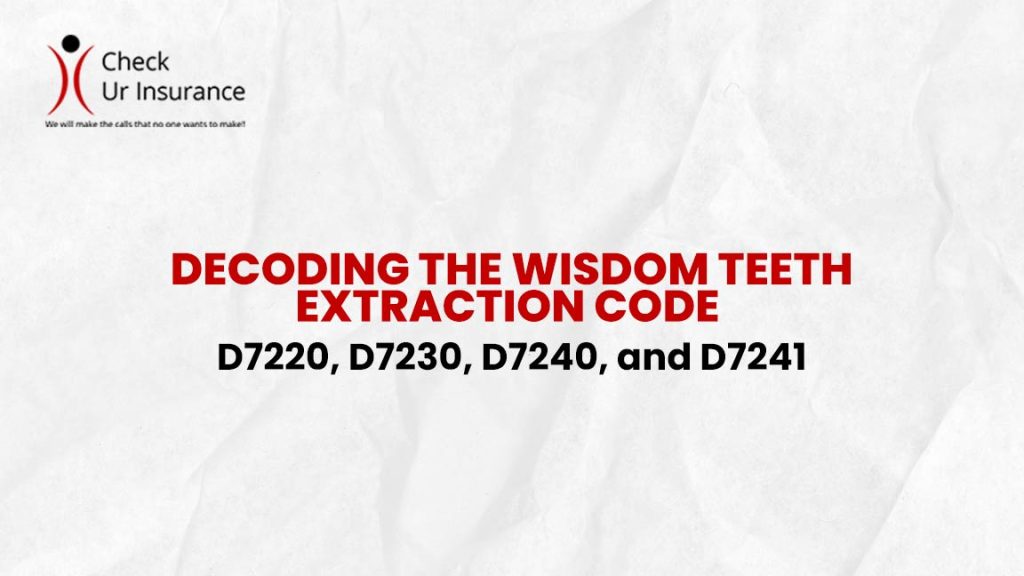Decoding the Wisdom Teeth Extraction Code: D7220, D7230, D7240, and D7241
Dealing with impacted wisdom teeth is no small feat. In this informative guide, we explore the specifics of wisdom teeth extraction codes D7220, D7230, D7240, and D7241. From soft tissue occlusion to complex surgical complications, understanding these codes is paramount for effective dental care.
Table of Contents
D7220: Removal of Impacted Tooth – Soft Tissue Occlusal Surface
Impacted teeth can wreak havoc on oral health. D7220 addresses the soft tissue occlusal surface scenario, where the tooth is covered by soft tissue, necessitating mucoperiosteal flap elevation for removal.
Impacted teeth, when buried beneath soft tissue, pose unique challenges. The D7220 code ensures a meticulous approach, involving the elevation of mucoperiosteal flap for precise extraction.
D7230: Removal of Partially Bony Impacted Tooth
When part of the crown is covered by bone, dental code d7230 comes into play. This wisdom teeth extraction code mandates both mucoperiosteal flap elevation and bone removal for a comprehensive extraction.
Partial bony impaction requires a strategic approach. D7230 outlines the protocol, ensuring both the soft tissue and bone hindrances are skillfully navigated for successful extraction.
D7240: Removal of Completely Bony Impacted Tooth
A more challenging scenario unfolds with D7240 dental code, where most or all of the crown is shrouded by bone. This extraction code demands elevated expertise, involving mucoperiosteal flap elevation and extensive bone removal.
Complete bony impaction calls for precision. D7240 details the steps, addressing the intricacies of both soft tissue and bone removal for a thorough extraction process.
D7241: Removal of Completely Bony Tooth with Surgical Complications
D7241 ventures into the realm of surgical complexity, reserved for cases with unusual challenges. From nerve dissection to maxillary sinus closure, this code tackles complications arising from unique factors.
Unusual surgical complications demand a specialized approach. D7241 encompasses scenarios where nerve dissection, maxillary sinus closure, or aberrant tooth position make the extraction particularly intricate.
FAQs: Demystifying Wisdom Teeth Extraction Code
Unraveling common queries surrounding the wisdom teeth extraction codes provides clarity for those undergoing or considering the procedure.
Is D7220 Suitable for Every Soft Tissue Impaction?
While dental code D7220 is a common code for soft tissue impactions, its applicability depends on individual cases. Consultation with a dental professional determines the most suitable extraction code.
How Long Does the Extraction Process Take for D7241 Cases?
The duration varies based on the specific complications. D7241 involves intricate steps, and the extraction time is determined by factors such as nerve dissection and maxillary sinus closure.
Are There Risks Associated with D7230?
Like any surgical procedure, D7230 carries minimal risks. The wisdom teeth extraction code emphasizes careful planning and execution to mitigate potential complications.
Can D7240 Handle Cases with Extensive Bone Coverage?
Yes, D7240 dental code is designed for situations where most or all of the crown is covered by bone. Dental professionals adept in this wisdom teeth extraction code ensure effective bone removal for a successful extraction.
Is D7241 Reserved for Rare Cases?
D7241 is indeed for unique surgical complications. While not common, it addresses scenarios where factors like nerve dissection or maxillary sinus closure are required, making the procedure unusually complex.
Can Wisdom Teeth Extraction Codes Change Post-Operatively?
Post-operative changes to extraction codes are rare. However, in unforeseen circumstances, dental professionals may reassess and modify the code based on the evolving situation.
Conclusion
Understanding the wisdom teeth extraction codes D7220, D7230, D7240, and D7241 provides a roadmap for individuals navigating impacted tooth scenarios. Armed with knowledge, patients and professionals alike can approach the extraction process with confidence.
Did you like this article? Read more helpful latest blogs.

